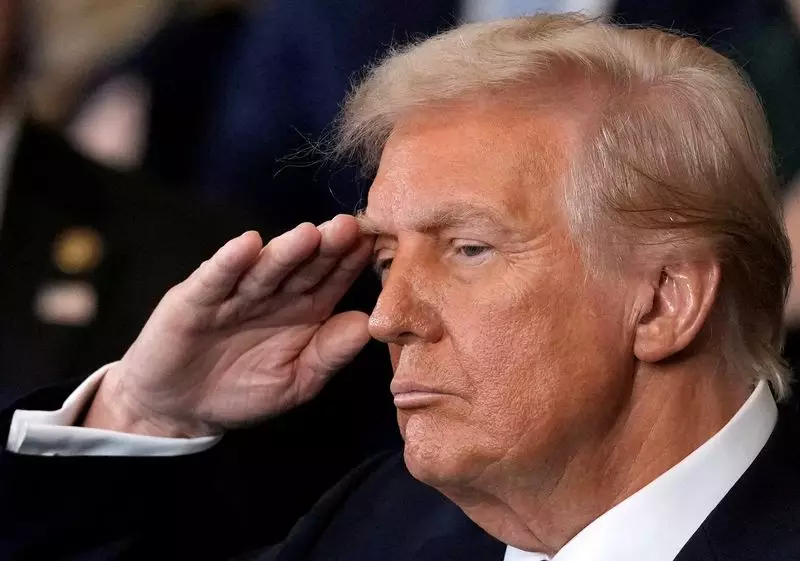In the wake of Donald Trump’s inauguration as the 45th president of the United States, significant changes were forecasted in the realm of trade policy. As a point of departure from conventional practice, President Trump would issue a trade memo that, while pausing on immediate tariff imposition, sets the stage for a comprehensive evaluation of trade relationships with key partners such as China, Canada, and Mexico. This strategic pivot not only alludes to Trump’s recognition of the economic implications of trade policies, but also opens a discussion on the potential ramifications for global markets.
The announcement signaling no immediate tariffs came as a relief to global investors, who reacted positively with an uplift in stock markets and a decline in the U.S. dollar’s value against other currencies. This initial decision reflects a shift from the fiercer, more impulsive tariff proposals that characterized Trump’s campaign rhetoric. Instead of plunging headfirst into trade wars, the new administration appears poised to adopt a more cautious methodology, directing federal agencies to scrutinize existing trade agreements and assess economic disparities.
In his inaugural address, Trump emphasized his commitment to revamping the trade framework to bolster American families and workers. His statements indicated a desire to replace the prevailing tax structures that he deems unfavorable, focusing instead on tariffs as a mechanism to enhance domestic wealth. While his verbal commitment to creating an “External Revenue Service” to oversee tariff collections indicates a proactive stance, it also suggests a calculated effort to maintain a level of stability in financial markets.
At the heart of Trump’s trade memo is the persistent issue of the U.S. trade deficit, particularly with nations like China, Canada, and Mexico. Trump’s administration has a historical focus on these relationships, which he has characterized as detrimental to American interests. His campaign promises of imposing tariffs ranging from 10% to 60% were aimed at reducing the astronomical trade deficit exceeding $1 trillion. The memo’s intent to evaluate compliance with prior agreements, such as the 2020 trade accord with China, underlines the administration’s commitment to enforcing existing frameworks rather than immediately disrupting them with aggressive tariffs.
Trade experts have noted that such investigations might progress through established statutes like Section 232 and Section 301, which would follow a methodical rather than abrupt approach. This change in tactic indicates that Trump may be considering the complexities involved in international trade dynamics and the long-term effects sudden policy shifts can create. Trade analysts posit that this cautious strategy might allow for targeted enforcement while also mitigating shocks to the economy.
As the news of Trump’s trade memo spread, the global marketplace responded positively. Market analysts observed a rebounding stock market and significant performance improvements in currencies like the euro, Canadian dollar, and Chinese yuan. The anticipated stability could signify a shift in investor sentiment, potentially paving the way for positive engagement between the U.S. and its trading partners.
Nonetheless, the groundwork laid out in the trade memo may only represent a temporary buffer against immediate tariff actions. Various experts in trade policy remain vigilant, speculating that Trump’s administration will likely resume its tariff pursuits later in his tenure. The historical context of Trump’s previous term, characterized by aggressive import tariffs and ongoing tensions with China, prompts questions about the longevity of this more diplomatic strategy. Trump’s commitment to an overarching tariff agenda — designated as a linchpin of his economic platform — remains steadfast, suggesting that this moderation might well be a precursor to more assertive measures.
Trump’s administration has long been entwined with the legacy of trade wars, particularly with China and North American partners. The prior imposition of tariffs on aluminum and steel highlighted his administration’s willingness to confront trade inequities directly. The subsequent truce reached with China in 2020, designed to bolster U.S. exports, underscores the importance of holding foreign nations accountable for previous commitments.
As the Trump administration seeks to navigate this intricate landscape, the fate of trade agreements, like the USMCA, remains uncertain. Trump’s earlier threats to withdraw from the North American Free Trade Agreement underscore an ongoing tension that persists today. This complex interplay of factors serves as a reminder that the trade policies adopted in the coming months will hold considerable weight in shaping not only the economic landscape of the United States but also the global trade environment.
In essence, while adherence to traditional trade tactics might offer a temporary respite, the broader implications of Trump’s policy intentions raise significant questions on the long-term trajectory of U.S. trade relations. Industry response and investor sentiment are likely to be paramount as these unfolding dynamics continue to evolve.

